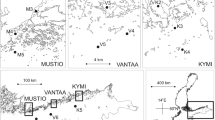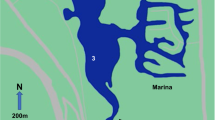Abstract
Salt marsh estuaries on the Georgia coast have been sites of classic studies leading to broad generalizations about the functioning of shallow estuarine ecosystems and the exchange of material between salt marshes and coastal waters. Several recent studies have suggested that these fundamental concepts need to be reevaluated. Not only are we uncertain as to the quantities of material fluxing in coastal ecosystems, we are also unsure of even the basic directions and mechanisms of exchange. Along the Georgia coast, the idea that salt marshes enrich coastal waters by the outwelling of organic detritus has been revised. The emerging concepts concerning these systems include: 1) algal-derived organic matter, from phytoplankton and benthic diatom photosynthesis within the estuary and just offshore, forms the bulk of organic seston, 2) vascular plant detritus is largely accumulated and consumed in marsh and estuarine sediments, 3) estuarine food webs are much more complex than has been thought, and 4) the most important roles of salt marshes in estuarine food webs are as refuges and feeding habitat for young and small animals, and as exporters of protein in the form of fish, crabs, and shrimp to coastal waters.
Problems worthy of attack Prove their worth by hitting back Piet Hein
Piet Hein (Grooks)
Contribution No. 382 of the University of Georgia Marine Institute
Access this chapter
Tax calculation will be finalised at checkout
Purchases are for personal use only
Preview
Unable to display preview. Download preview PDF.
Similar content being viewed by others
References
Adams, S. M. and J. W. Angelovic, 1970. Assimilation of detritus and its associated bacteria by three species of estuarine animals, Chesapeake Science 11: 249–254.
Christian, R. R. and R. L. Wetzel, 1978. Interaction between substrate, microbes, and consumers of Spartina detritus in estuaries, In: Estuarine Interactions, edited by M. Wiley, 93–114, Academic Press, N. Y.
Darnell, R. M., 1961. Trophic spectrum of an estuarine community based on studies of Lake Pontchartrain, Louisiana, Ecology 42: 553–568.
Dunstan, W. M. and L. P. Atkinson, 1976. Sources of new nitrogen for the South Atlantic Bight, In: Estuarine Processes Vol. 1 edited by M. Wiley, 69–78, Academic Press, N. Y.
Fallon, R. D. and F. K. Pfaender, 1976. Carbon metabolism in model microbial systems from a temperate salt marsh, Appl. Environ. Microbiol. 31: 959–968.
Fenchel, T., 1972. Aspects of decomposer food chains in marine bethos, Verh. Dtsch. Zool. Ges. 65: 14–22.
Gardner, L. R., 1975. Runoff from an intertidal marsh during tidal exposure-recession curves and chemical characteristics, Limnol. Oceanogr. 20: 81–89.
Hackney, C. T., 1977. Energy Flux in a Tidal Creek Draining an Irregularly Flooded Juncus Marsh, Ph.D. Dissertation, Mississippi State Univ.
Haines, E. B., 1975. Nutrient inputs to the coastal zone: The Georgia and South Carolina shelf, In: Estuarine Research Vol. 1 edited by L. E. Cronin, 303–324, Academic Press, N. Y.
Haines, E. B., 1977. The origins of detritus in Georgia salt marsh estuaries, Oikos 29: 254–260.
Haines, E. B., 1979. Pools of nitrogen in Georgia coastal waters, Estuaries 2: 34–39.
Haines, E. B., A. Chalmers, R. Hanson, and B. Sherr, 1977. Nitrogen pools and fluxes in a Georgia salt marsh, In: Estuarine Processes, Vol. 2, edited by M. Wiley, 241–254, Academic Press, N. Y.
Haines, E. B. and W. M. Dunstan, 1975. The distribution and relation of particulate organic material and primary productivity in the Georgia Bight, 1973–1974, Est. Coast. Mar. Sci. 3: 431–441.
Haines, E. G. and C. L. Montague, 1979. Food sources of estuarine invertebrates analyzed using ratios 13C/12C. Ecology 60: 48–56.
Heinle, D. and D. A. Flemer, 1976. Flows of material between poorly flooded tidal marshes and an estuary, Mar. Biol. 35: 359–373.
Herke, W. H., 1971. Use of Natural, and Semi-impounded, Louisiana Tidal Marshes as Nurseries for Fishes and Crustaceans, Ph.D. Thesis, Louisiana State Univ.
Kremer, J. N. and S. W. Nixon, 1978. A Coastal Marine Ecosystem, Simulation and Analysis, Ecological Studies 24, 217 pp., Springer-Verlag, N. Y.
Meade, R. H., 1969. Landward transport of bottom sediment in estuaries of the Atlantic Coastal Plain, J. Sed. Pet. 39: 222–234.
Minson, D. J., M. M. Ludlow, and J. H. Troughton, 1975. Differences in natural carbon isotope ratios of milk and hair from cattle grazing tropical and temperate pastures, Nature 256: 602.
Nadeau, R. J., 1972. Primary Production and Export of Plant Material in a Saltmarsh Ecosystem, Ph.D. Dissertation, Rutgers University.
Nixon, S. W., C. A. Oviatt, J. Garber, and V. Lee, 1976. Diet metabolism and nutrient dynamics in a salt marsh embayment, Ecology 57: 740–750.
Nixon, S. W., C. A. Oviatt, and S. S. Hale, 1975. Nitrogen regeneration and the metabolism of coastal marine bottom communities, In: The Role of Terrestrial and Aquatic Organisms in Decomposition Processes, edited by J. M. Anderson and A. MacFaden, 269–283, Blackwell Scientific Publ., London.
Odum, E. P. and A. de la Cruz, 1967. Particulate organic detritus in a Georgia salt marsh-estuarine ecosystem, In: Estuaries, edited by G. H. Lauff, 383–388, Pub. No. 83, AAAS.
Odum, W. E., 1970. Utilization of the direct grazing and plant detritus food chains by the striped mullet, Mugil cephalus, In: Marine Food Chains, edited by J. Steele, 222–240, University of California Press, Berkeley.
Odum, W. E. and E. J. Heald, 1975. The detritus based food web of an estuarine mangrove community, In: Estuarine Research Vol. 1, edited by L. E. Cronin, 265–286, Academic Press, N. Y.
Oertel, G. F., 1974. Delineation of coastal water masses by suspended sediment characteristics, Oral presentation, SEERS meeting, St. Augustine, Florida, Nov. 1974.
Oviatt, C. A. and S. W. Nixon, 1975. Sediment resuspension and deposition in Narragansett Bay, Est. Coast, Mar. Sci. 3: 201–217.
Pilkey, O. and D. Frankenberg, 1964. The relict-recent sediment boundary on the Georgia continental shelf, Bull. Ga. Acad. Sci. 22: 37–40.
Pilson, M. E. Q., C. A. Oviatt, G. A. Vargo, and S. L. Vargo, 1979. Replicability of MERL microcosms: initial observations, Symposium, Advances in Marine Environmental Research. U.S.E.P.A. (in press).
Pomeroy, L. R., L. R. Shenton, R. D. H. Jones, and R. J. Reimold, 1972. Nutrient flux in estuaries, In: Nutrients and Eutrophication, 274–291, Special ASLO Symposium 1.
Pomeroy, L. R., et al., 1977. Fluxes of organic matter through a salt marsh, In: Estuarine Processes, Vol. 2, edited by M. Wiley, 270–279, Academic Press, N. Y.
Ragotzkie, R. A., 1959. Phytoplankton productivity in estuarine waters of Georgia, Publ. Inst. Mar. Sci. Texas 6: 146–158.
Redfield, A. C., 1967. Postglacial change in sea level in the western North Atlantic Ocean, Science 157: 687–692.
Roman, M. R. and K. R. Tenore, 1978. Tidal resuspension in Buzzards Bay, Massachusetts. I. Seasonal changes in the resuspension of organic carbon and chlorophyll a, Est. Coast. Mar. Sci. 6: 37–46.
Sellner, K. G. and R. G. Zingmark, 1976. Interpretations of the 14C method of measuring the total annual production of phytoplankton in a South Carolina estuary, Bot. Marina 19: 119–125.
Sherr, B. F. and W. J. Payne, 1978. Effect of the Spartina alterniflora root-rhizome system on salt marsh soil denitrifying bacteria, Appl. Environ. Microbiol. 35: 724–729.
Smith, B. N., 1972. Natural abundance of the stable isotopes of carbon in biological systems, Bioscience 22: 226–231.
Smith, B. N. and S. Epstein, 1971. Two categories of 13C/12C ratios for higher plants, Plant Physiol. 47: 380–384.
Teal, J. M., 1962. Energy flow in the salt marsh ecosystem of Georgia, Ecology 43: 614–624.
Thomas, J. P., 1966. The Influence of the Altamaha River on Primary Production beyond the Mouth of the River, M. S. Thesis, Univeristy of Georgia.
Wiegert, R. C., R. R. Christian, J. L. Gallagher, J. R. Hall, R. D. H. Jones, and R. L. Wetzel, 1975. A preliminary ecosystem model of coastal Georgia Spartina marsh, In: Estuarine Research, Vol. 13 edited by L. E. Cronin, 583–601, Academic Press, N. Y.
Woodwell, G. M., D. E. Whitney, C. A. S. Hall, and R. A. Houghton, 1977. The Flax Pond ecosystem: exchanges of carbon in water between a salt marsh and Long Island Sound, Limnol. Oceanogr. 22: 833–838.
Author information
Authors and Affiliations
Editor information
Editors and Affiliations
Rights and permissions
Copyright information
© 1979 Plenum Press, New York
About this chapter
Cite this chapter
Haines, E.B. (1979). Interactions between Georgia Salt Marshes and Coastal Waters: A Changing Paradigm. In: Livingston, R.J. (eds) Ecological Processes in Coastal and Marine Systems. Marine Science, vol 10. Springer, Boston, MA. https://doi.org/10.1007/978-1-4615-9146-7_3
Download citation
DOI: https://doi.org/10.1007/978-1-4615-9146-7_3
Publisher Name: Springer, Boston, MA
Print ISBN: 978-1-4615-9148-1
Online ISBN: 978-1-4615-9146-7
eBook Packages: Springer Book Archive




